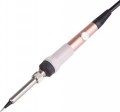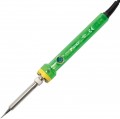Rated power of the soldering iron; in models with adjustments (see below) — the maximum rated power. The more powerful the tool, the more intense the heat it provides, the better it is for working with large objects, such as soldering thick wires, repairing radiators, etc. However, excess power is just as undesirable as insufficient: a tool that is too “weak” will not achieve normal soldering quality, and a tool that is too “strong” will overheat the parts to be joined and may damage them (not to mention excessive power consumption). Therefore, you need to choose a soldering iron in terms of power, taking into account the work for which it is planned to be used.
So, low-power models up to 10 W are intended mainly for miniature parts and delicate work — like soldering microcircuits. The best option for domestic use is 25 – 35 W; for large elements, you can use more powerful models,
up to 50 W ; these same indicators will suit most radio amateurs. Soldering irons for
50 – 100 W are designed mainly for thick wires, found, for example, in the on-board networks of cars; and high power is typical for a tool designed for large structures: metal containers (pots, buckets, etc.), radiators of the same cars, etc.
A separate case are models for soldering plastic pipes (see "Type"): they give out at least 700 W, and in the most powerful models, the figures can exceed 2 kW. Here, the more powerful the
...tool is, the larger the pipes with which it can work: for example, 700 – 800 W is enough for parts with a diameter of 20 – 25 mm, and for 63 mm pipes it will take no less than the mentioned 2 kW.
Some soldering irons have power controls (see below) that allow you to adjust them to a particular situation and expand the possibilities of application.
Note that high power in itself does not mean a high operating temperature — it only facilitates and accelerates heating.The minimum bar for operating temperature for models with the function of adjusting the "degree" of heating of the executive body. This ranges from a modest 50°C in plastic pipe soldering irons to over 200°C in advanced soldering stations.
The highest temperature to which the soldering iron can heat the material being processed. This temperature should be high enough to melt the solder or other workpiece material (such as polypropylene in soldered pipes), but not too high so as not to overheat the joint. Therefore, the choice for this indicator depends on the features of the planned work.
Note that in most household soldering irons for 20 – 60 W, the maximum temperature varies between 300 – 400 °C — this is enough to work with most solders used in radio engineering. In more powerful contact models, as well as soldering stations (see "Type"), there are indicators of the order of 700 – 800 °C — this allows you to work without problems with refractory solders, the melting point of which starts from 450 °C. For models designed for plastic pipes, the standard indicator is 300 °C — it is this temperature (or slightly lower, about 280 °C) that is considered optimal for soldering polypropylene. And the highest temperatures — 1300 °C and more — are able to provide gas soldering irons (see "Power")

